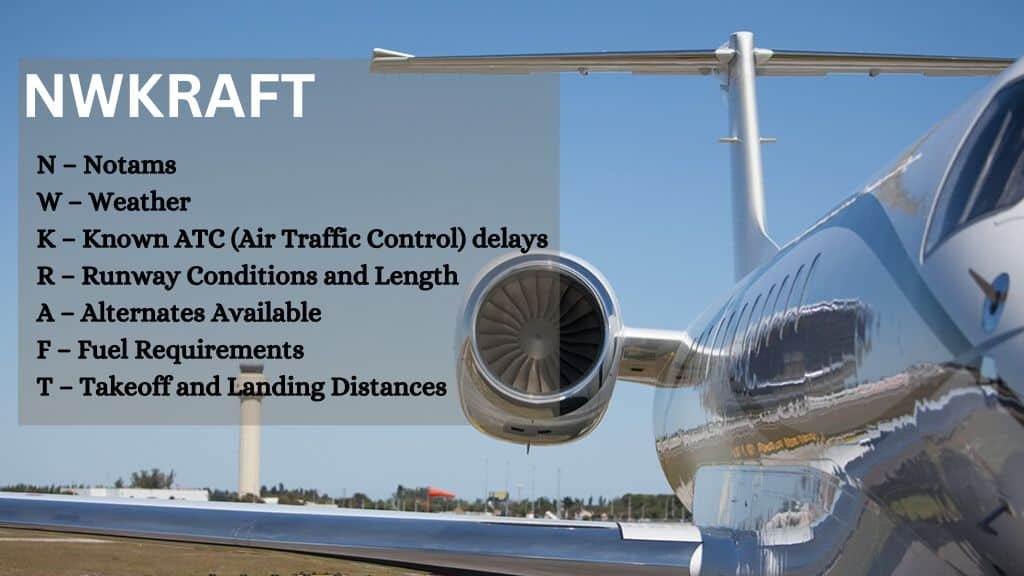Navigating an aircraft demands immense precision, unwavering attention, and a deep understanding of aviation’s multifaceted aspects. It’s imperative for pilots to prioritize flight safety by being aware of pivotal elements that shape the course of the journey. To aid pilots in remembering these crucial components, the aviation world employs various mnemonics, including NWKRAFT.
Are you unfamiliar with NWKRAFT in the aviation industry? You’ve landed on the right page. In this piece, we’ll unpack the significance of NWKRAFT, its roots, and its application in the field of aviation. Additionally, we’ll delve into the crucial role this acronym plays in reinforcing flight safety.
What is NWKRAFT?
NWKRAFT represents a mnemonic in the aviation sector which signifies:
N – Notams
W – Weather
K – Known ATC (Air Traffic Control) delays
R – Runway Conditions and Length
A – Alternates Available
F – Fuel Requirements
T – Takeoff and landing distances
This checklist serves as a vital tool for pilots to review prior to every flight, enhancing the safety and effectiveness of their missions. By offering a holistic view of their flight strategy, the NWKRAFT list aims to reduce potential mishaps and ensure secure aviation practices.
What Does NWKRAFT Stand for?
NWKRAFT stands for NOTAMs, Weather, Known ATC delays, Runway lengths, Alternatives available, Fuel requirements, and Takeoff and landing distances. This mnemonic assists pilots in recalling vital preflight checks, as outlined in 14 CFR 91.103. It’s crucial for pilots to have a grasp on these elements before embarking on a flight.
Read More: Flight Attendant Quotes
The Importance of NWKRAFT in Aviation
The NWKRAFT checklist plays a pivotal role in maintaining aviation safety. It offers pilots a consistent method to evaluate the security and practicality of their flight routes. Through this checklist, potential safety risks can be pinpointed and addressed accordingly.
Furthermore, the NWKRAFT checklist facilitates clear communication between pilots and air traffic control. This guarantees that pilots stay informed of any existing ATC interruptions, allowing them to make educated choices about their journey.
Familiarizing oneself with aviation shorthand like AVIATE, IMSAFE, and ATOMATOFLAMES is key to ensuring both personal and aerial safety!
How is NWKRAFT Used in Aviation?

Pilots utilize NWKRAFT to gauge the safety and viability of their flight itinerary. Let’s delve into each component of this checklist:
NOTAMs
NOTAM stands for Notice to Airmen, which has been updated to Notice to Air Missions in the US. In essence, NOTAMs are alerts that give details that might influence or threaten an aircraft on its flight path, such as a runway being shut down.
For those flying general aviation, NOTAMs can be accessed at a flight briefing station at airports, through apps like ForeFlight, or on websites like the US Federal NOTAM System (FNS).
In the context of airlines, the airline itself provides the relevant NOTAMs to their pilots for their specified route. This information is often curated by flight dispatchers and presented to pilots in either printed or electronic format during the flight preparation phase.
Weather
Weather plays a pivotal role in flight safety. It’s imperative for pilots to be informed about the present and predicted weather conditions at their starting point, along their route, and at their final destination. To achieve this, they gather data from multiple avenues, including weather briefings, predictions, and radar imagery.
Visibility is vital when assessing whether the climatic conditions are favorable for both takeoff and landing. It’s the pilot’s responsibility to confirm that the visibility levels are adequate for secure operations. Moreover, the wind’s velocity and direction are crucial as they can considerably influence the plane’s efficiency during ascent and descent.
It’s also crucial for pilots to factor in the type and strength of precipitation, as this can impact the plane’s ability to hold its altitude and sight range. Other meteorological challenges include thunderstorms, turbulent air, and ice formation, which pilots need to recognize and sidestep.
Besides the aircraft’s inbuilt weather tools, pilots also lean on meteorological updates and forecasts offered by air traffic controllers and other platforms. Based on the prevailing weather circumstances, pilots must make knowledgeable choices and, if necessary, modify their routes to prioritize safety.
In essence, the weather is of paramount importance in aviation, demanding pilots to continuously track and adapt to meteorological shifts to guarantee a safe journey.
Read Also: Cebu Pacific Flight Attendant
Known ATC Delays
Delays from Air Traffic Control (ATC) can arise due to a range of factors, including heavy air traffic, shutting down of runways, or technical issues with equipment. Such setbacks can alter a flight’s timing and fuel usage. Hence, it’s crucial for pilots to be informed of any anticipated ATC delays while planning their flight.
By keeping abreast of potential ATC interruptions, pilots can tweak their flight strategy, set-off time, or pathway to reduce the effects of these hold-ups on their journey.
Runway Conditions and Length
During both pre-flight preparations and in-flight evaluations, runway conditions, and their length stand as vital considerations for pilots. Elements like the surface material, the presence of contaminants (like snow, ice, or water), and the overall length of the runway can play significant roles in determining aircraft efficacy, required distances for takeoff and landing, and optimal approach velocities.
It’s essential for pilots to consult the most recent reports on runway conditions and ensure that the length of the runway at the destination airport aligns with the specifications and performance of their aircraft. They should also be vigilant to any changes in runway statuses while in the air, as it might call for alterations in landing or approach techniques.
Alternates Available
Having backup airports in mind is crucial if the primary destination becomes inaccessible because of unexpected events like worsening weather, runway obstructions, or emergencies. When mapping out their flight, pilots ought to pinpoint appropriate alternate airports on or near their route, considering aspects such as the condition and length of runways, the services offered, and fuel provisions.
A thoroughly considered alternate airport strategy enables pilots to swiftly and judiciously respond to unforeseen challenges, guaranteeing the flight’s safety and the well-being of its passengers.
Fuel Requirements
Fuel stands as a paramount component in ensuring flight safety. It’s imperative for pilots to verify that their aircraft is sufficiently fueled to finish the journey securely. This involves considering the flight’s length, prevailing weather conditions, and possible detours.
Moreover, pilots are tasked with determining the necessary fuel quantity for various flight phases, encompassing takeoff, ascent, cruising, descent, and touchdown. They must also provision for unexpected scenarios, like delays from air traffic or alterations to the planned route.
Throughout the flight, meticulous fuel oversight is essential, obliging pilots to regularly track fuel usage and recalibrate their flight strategy if needed.
Also Read: Flight Attendant Salary
Takeoff and Landing Distances
Before initiating a flight, it’s vital to determine the takeoff and landing lengths at the departure, target, and backup airports. Both the Pilot’s Operating Handbook (POH) and the Airplane Flight Manual (AFM) contain performance charts or diagrams to assist with these calculations.
Furthermore, aviation standards stipulate specific criteria and minimums concerning takeoff and landing distances. For reference, one can refer to 14 CFR 25.113 for takeoff and 14 CFR 25.125 for landing provisions.
Airline pilots frequently employ performance calculators or dedicated apps, inputting pertinent details (like the aircraft’s weight, ambient temperature, and so forth) to deduce the required distances for takeoff or landing.
Tips for Effectively Using NWKRAFT
Here are some strategies for pilots to maximize the benefits of the NWKRAFT acronym:
- Stay Systematic: Adopt a structured method to collect and evaluate details pertaining to each component of NWKRAFT. This not only refines the pre-flight preparation process but also ensures comprehensive consideration of all vital factors.
- Stay Updated: Remain vigilant to any alterations or new information related to NWKRAFT throughout your journey. By consistently refreshing your understanding of these elements, you can uphold situational clarity and make more informed choices as situations evolve.
- Harness Modern Tech: Utilize contemporary technologies like Electronic Flight Bags (EFBs), flight preparation software, and meteorological apps to amass, structure, and interpret data in line with NWKRAFT. These digital resources empower pilots with the insights needed to anticipate and respond to potential flight challenges.
Case Studies: NWKRAFT in Action
To emphasize the significance of the NWKRAFT acronym, let’s consider two case studies:
Successful Use of NWKRAFT
In one instance, a pilot meticulously checked all pertinent NOTAMs, weather forecasts, and fuel prerequisites before flying. By identifying potential ATC hold-ups and route traffic ahead of time, the pilot tweaked the departure schedule and path. This proactive approach allowed the pilot to sidestep these challenges, culminating in a safe and efficient flight.
Lessons Learned from NWKRAFT-related Incidents
Contrastingly, another pilot overlooked examining the runway conditions at their intended destination. This oversight led to an attempt to land on a compromised runway. Consequently, the plane overshot the runway, incurring significant damages. Such an episode underscores the necessity of an exhaustive review of all NWKRAFT elements during pre-flight preparations, as well as the need for constant alertness during the flight.
Read Also: Philippine Airlines Flight Attendant
Conclusion
In summary, safety in aviation is paramount. The NWKRAFT checklist offers pilots a structured method to pinpoint potential threats and decide on measures to counteract them. By adhering to this checklist, pilots can confirm they’ve addressed all vital considerations, both before ascending and while airborne. This encompasses aspects like navigation, weather conditions, ATC delays, Runway Conditions and Length, alternate airports, fuel requirements, and Takeoff and landing distances.
It’s imperative for pilots to recognize that ensuring safety is a collective endeavor, involving not just them but also other key players like air traffic controllers, maintenance crews, and airport managers. Collaborative efforts, grounded in recognized safety standards, can consistently guarantee secure and streamlined air transport for both passengers and goods.
At its core, the primary focus in aviation is safety. All choices made by pilots and their counterparts in the industry should underscore this principle. In this context, the NWKRAFT checklist stands out as an instrumental guide for pilots, helping keep safety central to their judgments.
Frequently Asked Questions (FAQs) about NWKRAFT
What is Nwkraft used for?
The NWKRAFT checklist assists pilots in conducting preflight checks and guaranteeing a comprehensive flight plan. Notice to air missions (NOTAMS) are alerts submitted to aviation authorities to inform pilots about potential risks either along their intended route or at specific locations within their journey.
Who created the NWKRAFT?
The Federal Aviation Administration (FAA) in the United States originally introduced the NWKRAFT acronym. It emerged from the FAA’s initiative to unify flight protocols and enhance aviation safety. While the NWKRAFT checklist began its journey with commercial airlines, it has now been adopted as a regular procedure by pilots universally.
Why is the NWKRAFT checklist important in aviation?
The NWKRAFT checklist aids pilots in pinpointing potential safety risks, enabling them to make educated choices to counteract them. It’s a crucial instrument for pilots, ensuring the well-being of their flights, passengers, and onboard staff.
















[…] READ: NWKRAFT […]
Comments are closed.